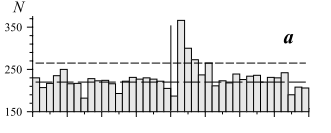
active faults.
At present, the cooperation between EMSEV and the Philippines Institute of Volcanology and Seismology (PHIVOLCS, The Philippines) on the slow
awake of Taal volcano (The Philippines) is running well.
Therefore, EMSEV now promotes investigations on the generation of earthquakes and on the electrical/magnetic signals which could accompany
such events. Along the past EMSEV business meeting, it was discussed the setting of a scientific cooperation between the Research Station of the
Russian Academy of Science in Bishkek (Kyrgyz) and EMSEV.
The scope of the cooperation will be
Research Station in Kyrgyz (Director Anatoly Rybin, EMSEV member). Their experiment involves injecting powerful electrical currents from through 4.
5-km long dipoles. This is literally one of the world's largest scale electric/electromagnetic prospecting experiments.
Through this experiment, they found resistivity changes prior to some moderate earthquakes with a few percents. They also claimed that these
resistivity changes recovered after the impending seismic activities (Fig. 1).

According to their reports, released seismic energy was 106 times greater than the injected one (Fig. 2). It means current injection triggered seismic
activity. This is really astonishing results. However, almost all such results were obtained during the former Soviet Union era. Therefore, these results
have not been well recognized even now for all over the world. This situation was really grievous.
EMSEV bureau members (S. Uyeda and T. Nagao) with others have visited the Research Station a couple of times and were much impressed and
agreed to a need for close international cooperation in the further. The major aim of the first workshop is to get the exact information of what
Bishkek scientists did.

Proposal:
The following target experiments are suggested for cooperative studies with the Research Station in Kyrgyz:- 3D modelling of the source region(s) where electrical conductivity changes are occurring,
- Detailed investigation of correlation between electrical conductivity changes and seismicity,
- Electromagnetic triggering processes and their implications,
- Distortion of electrical signals by regional tectonics and faults systems,
- Common field experiments,
- Independent checking of VAN'S SES observations outside Greece,
- Physical mechanisms of EM signals generated by the MHD-generator.
Kick-Off meeting:
The first joint Bishkek-EMSEV meeting will be held at the RAS Bishkek station in Kyrgyz from November 8 to 12, 2011.
Topics of the workshop:
Important results obtained at Bishkek so far include: observations of changes in electrical conductivity of as much as several percent before moderate earthquakes and sharp increases in triggered local seismicity that results from the operation of the injection experiment. Furthermore, the
receiving stations in Kyrgyz are extremely remote and are relatively free of artificial noise sources. This provides an ideal environment for checking
high-resolution monitoring experiments such as SES proposed by the VAN group in Greece. Complementary experiments to those led by the
Research Station will be envisioned.
Specific talks will be given on:
1) Historical experiments by using MHD generator
2) Current (on-going) active monitoring experiments by using the 4km transmitting dipole
3) Geological/geophysical setting in and around the Bishkek test site
4) Resistivity structure around the Bishkek test site
5) Analysis methods of resistivity structures (which is similar to TDEM)
6) Temporal resistivity changes associated with earthquakes
7) Induced seismicity after the current emission experiments
General topics will be developed on:
- Detailed investigation of correlation between electrical conductivity changes and seismicity,
- Detailed 3D resistivity structure in the vicinity
- Electromagnetic triggering processes and their implications,
- How to make independent checking of VAN'S SES observations outside Greece,
- Physical mechanisms of EM signals, etc.
Organizing committee:
Anatoly Rybin (Director, Research station RAS, Bishkek): rybin@gdirc.ru
Gennady Schelochkov: tgg@gdirc.ru
Vladimir Zeigarnik: zeigarnik@ihed.ras.ru
Gennady Sobolev: sobolev@uipe-ras.scgis.ru
Jacques Zlotnicki: jacques.zlotnicki@wanadoo.fr
Malcolm J. S. Johnston: mal@usgs.gov
Toshiyasu Nagao: nagao@scc.u-tokai.ac.jp
Seiya Uyeda: suyeda@st.rim.or.jp
Contact address:
Research Station RAS, Bishkek-49, 720049, Kyrgyz
Fax: 996 (312) 611459
Tel: 996 (312) 613140
Anatoly Rybin: tua@gdirc.ru, rybin@gdirc.ru
Timetable:
Nov. 8 Arrival to Bishkek, registration
Nov. 9 Workshop
Nov. 10 Workshop
Nov. 11 Field excursion
Nov. 12 Departure for home and additional field work for those interested
(We expect about 20 foreign participants.)
Accommodation:
Bishkek Research Station has guest rooms.
They provide a room for 80US$ including three meals for night.
Travel to Bishkek:
The most convenient way to get Bishkek, Kyrgyz is from Moscow and Istanbul. The other way is via Almaty, Kazakshstan which is located 250 km
from Bishkek. The Research Station can provide transport from Almaty to Bishkek. In the case of route Almaty (airport) - Bishkek (Research
Station) it is necessary to have 2 visas: transit visa to Kazakhstan and main visa to Kyrgyz.
|
|

